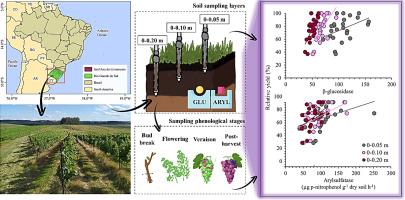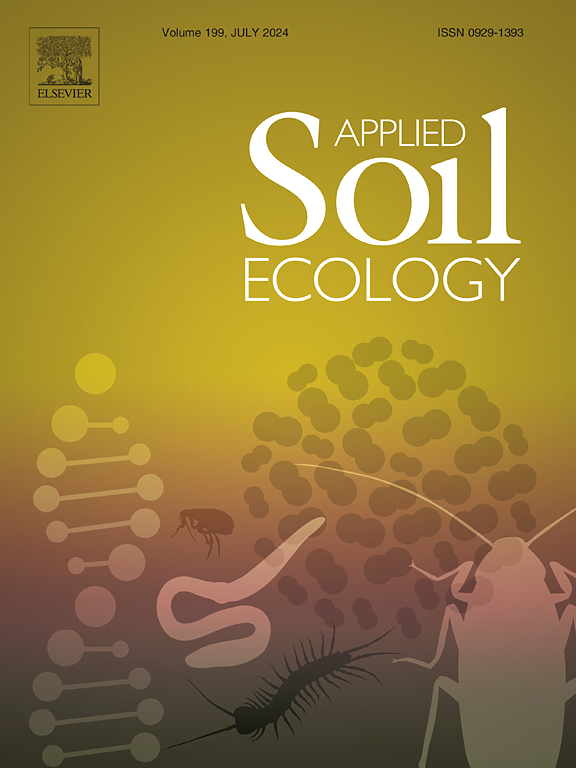Relationships between yield, enzymatic activity, and chemical properties across different soil layers and phenological stages of grapevines in southern Brazil
IF 4.8
2区 农林科学
Q1 SOIL SCIENCE
引用次数: 0
Abstract
The activities of the enzymes β-glucosidase (GLU) and arylsulfatase (ARYL) in annual crop soils can now be determined in several commercial laboratories in Brazil. The results are used to assess soil quality and recommend management practices. However, this technology is not yet available for vineyards. The objective of this study was to evaluate whether the activities of soil GLU and ARYL enzymes are related to grapevine yield and chemical properties in sandy vineyard soils, and to define the phenological stage of the crop and the soil sampling layer that best characterize these relationships. Soil and plant samples were collected in a commercial Vitis vinifera L. vineyard located in the extreme south of Brazil during the 2022/23. The soil was sampled in three layers (0–0.05, 0–0.10, and 0–0.20 m) and at four phenological stages (bud burst, full flowering, veraison, and post-harvest). The activities of the soil enzymes GLU and ARYL, the nutrient content of the soil and the leaf, the quality of the must, and the relative yield (RY) of the grapevine were evaluated. The RY was related to the activity of these enzymes. The best regression model adjustments were observed after harvest and in the 0–0.10 m layer. Enzyme activity was also significantly related to soil organic C and total N, as well as other soil properties, mainly P, K, Ca, Mg, Zn, and Mn. The activities of GLU and ARYL enzymes were related to grapevine yield and chemical properties in sandy vineyard soils and soil sampling in the 0–0.10 m layer after harvest is recommended.

巴西南部不同土壤层和不同物候期葡萄产量、酶活性和化学特性之间的关系
现在,巴西的一些商业实验室可以测定一年生作物土壤中β-葡萄糖苷酶(GLU)和芳基硫酸酯酶(ARYL)的活性。检测结果可用于评估土壤质量和推荐管理方法。然而,这项技术还不能用于葡萄园。本研究的目的是评估土壤中 GLU 和 ARYL 酶的活性是否与葡萄产量和沙质葡萄园土壤的化学特性有关,并确定最能体现这些关系的作物物候期和土壤采样层。2022/23 年期间,在巴西最南部的一个商业葡萄园采集了土壤和植物样本。土壤采样分三层(0-0.05 米、0-0.10 米和 0-0.20 米),在四个物候期(花蕾期、盛花期、成熟期和采收后)进行。对土壤酶 GLU 和 ARYL 的活性、土壤和叶片的养分含量、葡萄汁的质量以及葡萄的相对产量(RY)进行了评估。相对产量与这些酶的活性有关。收获后和 0-0.10 米层的回归模型调整效果最佳。酶活性还与土壤有机碳和全氮以及其他土壤特性(主要是磷、钾、钙、镁、锌和锰)密切相关。GLU和ARYL酶的活性与葡萄产量和沙质葡萄园土壤的化学特性有关,建议在采收后对0-0.10米土层进行土壤采样。
本文章由计算机程序翻译,如有差异,请以英文原文为准。
求助全文
约1分钟内获得全文
求助全文
来源期刊

Applied Soil Ecology
农林科学-土壤科学
CiteScore
9.70
自引率
4.20%
发文量
363
审稿时长
5.3 months
期刊介绍:
Applied Soil Ecology addresses the role of soil organisms and their interactions in relation to: sustainability and productivity, nutrient cycling and other soil processes, the maintenance of soil functions, the impact of human activities on soil ecosystems and bio(techno)logical control of soil-inhabiting pests, diseases and weeds.
 求助内容:
求助内容: 应助结果提醒方式:
应助结果提醒方式:


